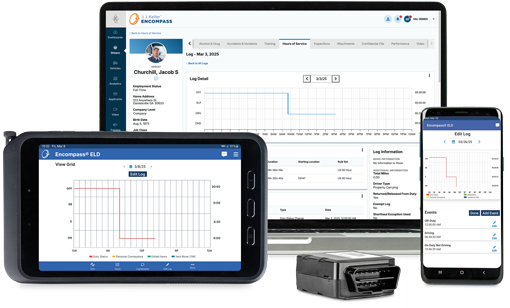Editorial Content Manager — J. J. Keller & Associates, Inc.
Last Minute Driver Prep for Canada's ELD Mandate
Here are a few last-minute pointers for you and your drivers as you roll out your ELD program to comply with Canada's ELD mandate.
Published On: 06/04/2021


Written by:
Heather Ness
The Canadian electronic logging device mandate (ELD) is inching closer to the June 12, 2021, effective date. Yet, an educational enforcement period is giving carriers and drivers a little more time to prepare. You’ll want to use this time wisely, especially when it comes to your driver’s training.
Here are a few last-minute pointers for you and your drivers as you roll out your ELD program:
Reminders on Hours’ Limits
ELDs track driver hours to the minute, which means drivers need to pay close attention to their accumulated time (hours and minutes), particularly drive time, on-duty time, and off-duty time.
For example, drivers need to ensure they take a full 8-hour core rest break, not a 7-hour, 59-minute core rest break. Drivers cannot drive 13 hours, 1 minute in a day or workshift. The ELD may flag these seemingly minor types of events as violations. The same is true for the 10 hours off duty required in a day; off-duty periods must be at least 30 minutes to count towards the total 10 hours for the day.
The good news is that ELDs help drivers with some of these time management issues. They notify drivers audibly when they’re close to approaching a driving limit and cycle limits.
Driver Responsibilities at Roadside Inspections
Roadside inspections will be different for drivers, and you’ll need to train drivers on these differences. Officers will request to view the ELD display and expect drivers to email the records of duty status.
Ensure your drivers are fully compliant by having necessary ELD-related documentation: the ELD user manual, instructions describing data transfer options and how to transfer data to an officer, ELD malfunction instructions, and at least 15 days’ worth of blank logs.
If your drivers operate under an exemption (always or occasionally), make sure they have the necessary documentation and understand how the exemption applies to them. For example, drivers operating rental commercial vehicles with a rental agreement of 30 days or less aren’t required to use an ELD. In this case, the driver must have proof of the rental agreement during operation and present it to an officer upon request.
Supporting Documents
Drivers have always been required to collect supporting documents each day. However, the Canadian ELD mandate added a clear definition of supporting documents, including the types of records expected.
Educate your drivers. Supporting documents include:
- Any electronic mobile communication record reflecting communications between a driver and a motor carrier transmitted through a driver call-in or fleet management system;
- Any payroll record, settlement sheet, or equivalent document that indicates payments to the driver;
- Any government-issued document showing the location of the commercial vehicle;
- Any reports, receipts, records, or other documentation relating to the load of the commercial vehicle, including any bill of lading, itinerary, schedule, or equivalent document that indicates the origin and destination of each trip;
- Any reports, receipts, records, or other documentation relating to the servicing, repairing, conditioning, fueling, inspection, or rental of the commercial vehicle; and
- Any reports, dispatch or trip records, receipts, or other documentation indicating the date, time, or location of the commercial vehicle during a trip, including arrival and departure times.
Note that drivers exempt from ELDs, such as those operating within the 160-kilometer radius (and meeting all conditions), also need to collect supporting documents.
ELD Malfunctions
Like all technology, ELDs can malfunction, and drivers must be aware of the required steps to take. If a malfunction occurs, the driver must:
1. Notify the designated representative at the motor carrier as soon as the vehicle is parked.
2. Add an annotation in the record of duty status for the day that the malfunction was noticed, and include:
- The malfunction or data diagnostic code displayed on the ELD,
- The date and time when the malfunction or data diagnostic code was noticed, and
- The time when the notification was made to the motor carrier.
3. Include the malfunction code on each days' record of duty status until the ELD is replaced and repaired (up to 14 days allowed).
Going Forward
With the year-long educational enforcement period, fleets need to stay on top of ELD-related federal and provincial communications.
If your fleet hasn’t researched, chosen, or installed ELDs, you need to get started. Consider J. J. Keller® ELogs. With a quick 10-minute installation, hardware updates over the air, and the ELD Quick Comply Program, you can be compliant in a short amount of time — with the leader in hours-of-service compliance. Call us today at 855.693.5338 or request a call with a compliant specialist.
You may also enjoy the following articles:
Sign up for our newsletter!
We'll help you stay on top of regulations, best practices, and fleet industry news. Sign up to receive a monthly email notification with links to our most recent blog articles, free resources, and event invites.
